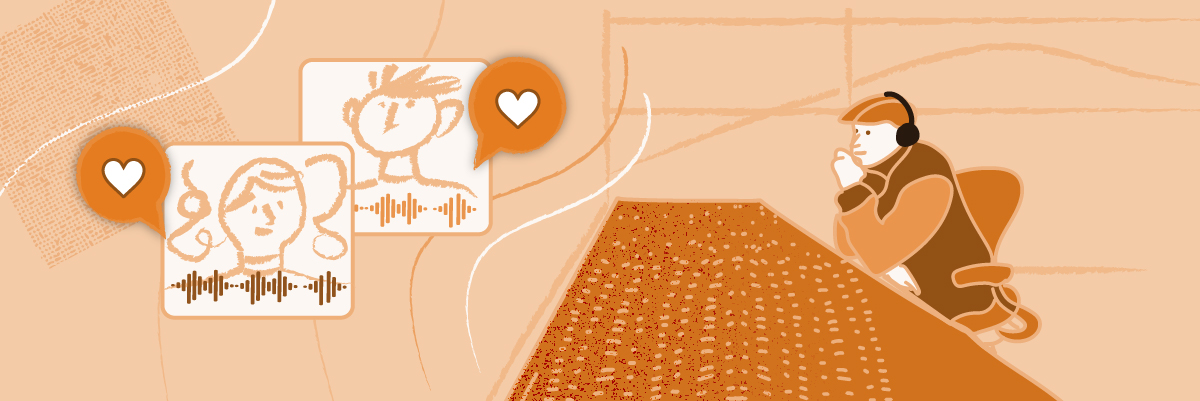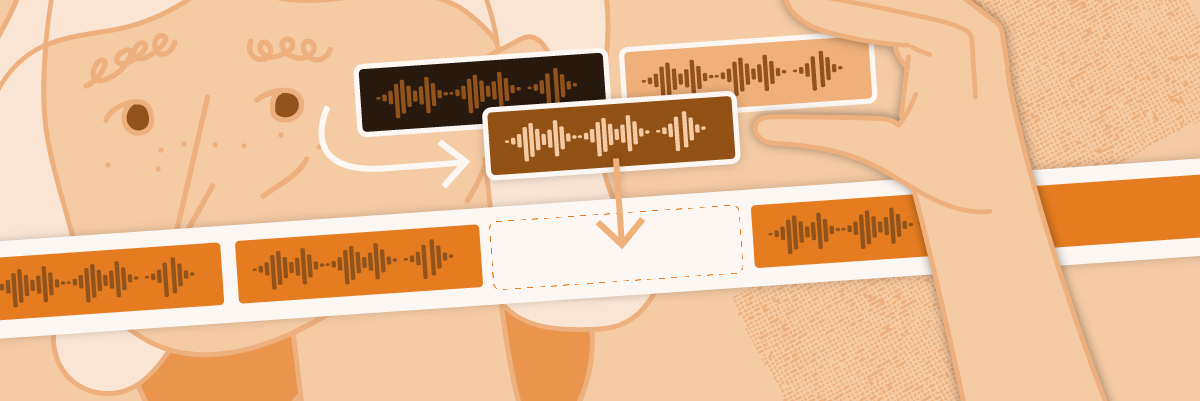Is audio advertising a thing of the past? With such widespread use of video advertising, many entrepreneurs share that view. Still, current audio advertising trends speak to the contrary. A big role in those trends now belongs to dynamic audio advertising. So, what are we talking about, then?
When defining the term dynamic audio advertising, the word ‘dynamic’ might confuse people. Dynamic audio doesn’t mean just using uptempo music or a fast-paced vocal message. When defining dynamic audio advertising two other definitions are in order first.
One is dynamic content. Dynamic content is defined as any digital or online content that changes based on data, user behavior, and preferences. This can be text, audio, or video format content. Hence, dynamic audio is a form of dynamic content.
The other term that needs adding here is programmatic advertising. In this case, programmatic audio advertising. According to one definition, programmatic audio is the use of technology (software) to automate the process of buying and inserting ads in digital audio content. These include music streaming services, digital radio, and podcasts, as opposed to the traditional process of human negotiation. “Using this powerful advertising medium, you can refine your targeting, improve engagement and gather advanced reporting insights.”
If we take the above terms in perspective, dynamic audio advertising would be the use of audio ads that would “automatically change to adapt content and promotions specifically to each user, ensuring that each user is exposed to the most effective creative for him or her” (dynamicyield.com).
Still, a few questions remain open here. How do dynamic audio ads work, why would you take that advertising route, and, of course, will it cost an arm and a leg?
At Bunny Studio we are experts in audio advertisement solutions, including Dynamic audio ads production. So give a look at our 👉🏽 Dynamic audio ads services if you want to know more.
Are audio ads as such still relevant?
For those entrepreneurs that in the age of video still might doubt the necessity of any form of audio ads, there’s one fact they just need to look at. The success of audio streaming services such as Spotify or Tidal. Add to that the mushrooming of podcasts and audio-oriented social media platforms like TikTok.
According to digilant.com, the average consumer in the US now spends over 1.5 hours listening to digital audio every day. To put that number in perspective, when adding up all forms of media that consumers interact with every day, both digital and traditional, digital audio snags over 10% of the total.
“Consumers constantly switch between media and channels to consume and interact with content. Knowing that digital audio is a constant (and large) source of content consumption gives advertisers a huge window of opportunity to reach consumers as they move throughout their day” (above).
So, what kind of role does dynamic audio advertising play here? Dynamic audio advertising is a novel approach to advertising as it involves using artificial intelligence in advertising. Essentially, in many ways, it represents the advertising of tomorrow.
According to British digital advertising specialists IAB, tomorrow’s audio advertising will be more adaptive and much more relevant. “Creatives will be able to find the perfect tune to meet their branding needs, every time, at the touch of a button – and with none of the trade-offs that traditionally characterize soundbed1selection.”
“Media buyers will be able to seamlessly scale campaigns across publishers, platforms, and even demographics. Consumers will experience audio advertising as a seamlessly integrated part of their listening journey.”
The relevance of dynamic audio advertising and artificial intelligence
As IABUK (above) explains, the benefits of dynamic audio are already clear. “Advertisers have long seen the advantages of creating personalized audio experiences, but the costs of producing and scaling such campaigns were prohibitive. Quite simply, the technology didn’t exist.”
So what changed the scene? It was the advent of artificial intelligence and its growing application in the audio recording and playback field. It now gives those working in the audio field the capabilities to use “a broad pallet of sounds spanning voice, music, samples, beats, effects and more” (above).
These days, artificial intelligence in audio or, in trade jargon, machine learning-enabled dynamic audio:
- Bespoke2 audio production – where “the technology creates the ideal soundbed based on creative selections and voiceover.”
- Dynamic alteration of soundbeds to match a listener’s context.
- Enhancing the searching of music libraries by moving towards semantic search.3 (IABUK)
Essentially, the ability of AI to, say, ‘mix’ and produce new compositions instantaneously will make tailored audio a common component of advertising.
So, how should advertisers approach the use of artificial intelligence in dynamic audio advertising? The above source has the following recommendations:
- Simplicity – Production capabilities need to be intuitive so that audio can quickly be pulled together to reflect what people are doing at any given moment.
- Access – Ensure you have access to a broad sound library based on your needs.
- Automate everything – The right algorithms will automate everything from music discovery to content delivery, ensuring listeners’ smooth and seamless experience.

More on the advantages
Australian Signifimedia (above) looks at the advantages of dynamic audio advertising in the realm of its part of programmatic advertising in general. It lists the following advantages of programmatic audio advertising, of which dynamic audio advertising is a large part:
- Higher engagement – Programmatic audio does not rely on visual engagement and advertisers don’t have to compete for the user’s attention. “The majority of people listening to digital audio do so via headphones, which means that listeners aren’t able to listen to anything else while an audio ad rolls. This type of media consumption helps form a strong brand-listener bond.”
- The ability to reach a large audience – The rise of users on streaming services. Statista research shows that as of the first quarter of 2021, Spotify boasted a whopping 158 million premium subscribers worldwide, up from 130 million in the corresponding quarter of 2020.
- It is efficient and reliable – Using machines (AI) is a really efficient way of buying digital advertising space. “With the use of smart technology, the whole process is smoother and more cost-effective.”
- The ability to deliver more personalized ads – By being able to target based on real-time data, advertisers can engage audiences with much more relevant and personalized ads. This data includes elements like time of day, weather and traffic patterns, music-based psychographic groups, age, gender, purchase behavior, and other consumer trends.
- Digital audio listeners are a valuable audience – “Podcast listeners typically have university-level education, are employed and earn a yearly household income above 100,000 USD.”
- Forming long-lasting relationships with a younger audience.
- Being Less reliant on third-party cookies – People are increasingly consuming digital audio media across devices and apps, which requires users to log in. Programmatic audio advertising doesn’t rely on third-party cookies.
How to approach digital audio advertising
So, how should entrepreneurs and advertisers approach dynamic audio and digital audio advertising in general? Digilant (above) gives the following six tips:
- Control the length of each ad – The 30-second audio spot is common, but it may not perform the best for every advertiser. “Shorter spots of 10-15 seconds can be a more effective way to hold listeners’ attention.” Advertisers should test out both lengths to see what performs best based on their goals.
- CTA (call-to-action) – Every audio ad should include a clear call-to-action (CTA) within the first 10 seconds of the audio spot. Advertisers should keep in mind that listeners are not always looking at the screen. They may be commuting, exercising, or working on another screen.
- Ad frequency – “Audio offers a focused one-to-one connection; therefore, the frequency of your ad being heard is essential. You want your ad to be memorable but not annoying to the audience. A good middle ground is three to five times per week but obviously varies on a case-by-case basis.”
- The message has to remain fresh – The actual creation of the ad waivers on a fine line of memorable and annoyance. Audio creative that a listener hears over and over tends to drop in performance. Swap in new audio spots every few months for longer campaigns and feature product releases or seasonal promotions.
- Use conversational tone – “Streaming audio is a very intimate and personal medium, so the ad experience should be no different. Listeners are more receptive when brands use a conversational tone- as if you were speaking with the listener.“
- Ensure measurement – when setting audio KPI’s (key performance indicators), ensure that you are quantifying success in a way that is appropriate to the environment.
Who to engage for your dynamic audio ads?
So, the preparation and use of dynamic audio advertising rely heavily on the use of relatively new technologies like artificial intelligence. Of course, handling such technology requires engaging experts in the field.
On the surface, that might sound like an expensive proposition. Yet, on the other hand, any form of advertising requires investment. And if invested properly and wisely, it usually reaps much higher rewards. Still, how do you get involved in dynamic audio advertising without breaking a bank?
The rapid development of modern technologies like artificial intelligence is ongoing and its use in advertising is often tied to specialized agencies. And as is often the case, advertising agencies have high prices.
Yet, the use of modern technologies, in this case in dynamic audio advertising too, is now quite common among freelancers with adequate expertise. In most instances, freelancers are usually able to offer the same level of service at a more competitive price.
- The term “soundbed” is used to describe the sonic landscape over which other sounds are added; i.e. a soundbed is the basic layer over which everything else is added. ↩
- Bespoke is a term to describe products and services that are commissioned by a customer ↩
- Semantic search is a data searching technique in which a search query aims to not only find keywords but to determine the intent and contextual meaning of the words a person is using for search ↩










